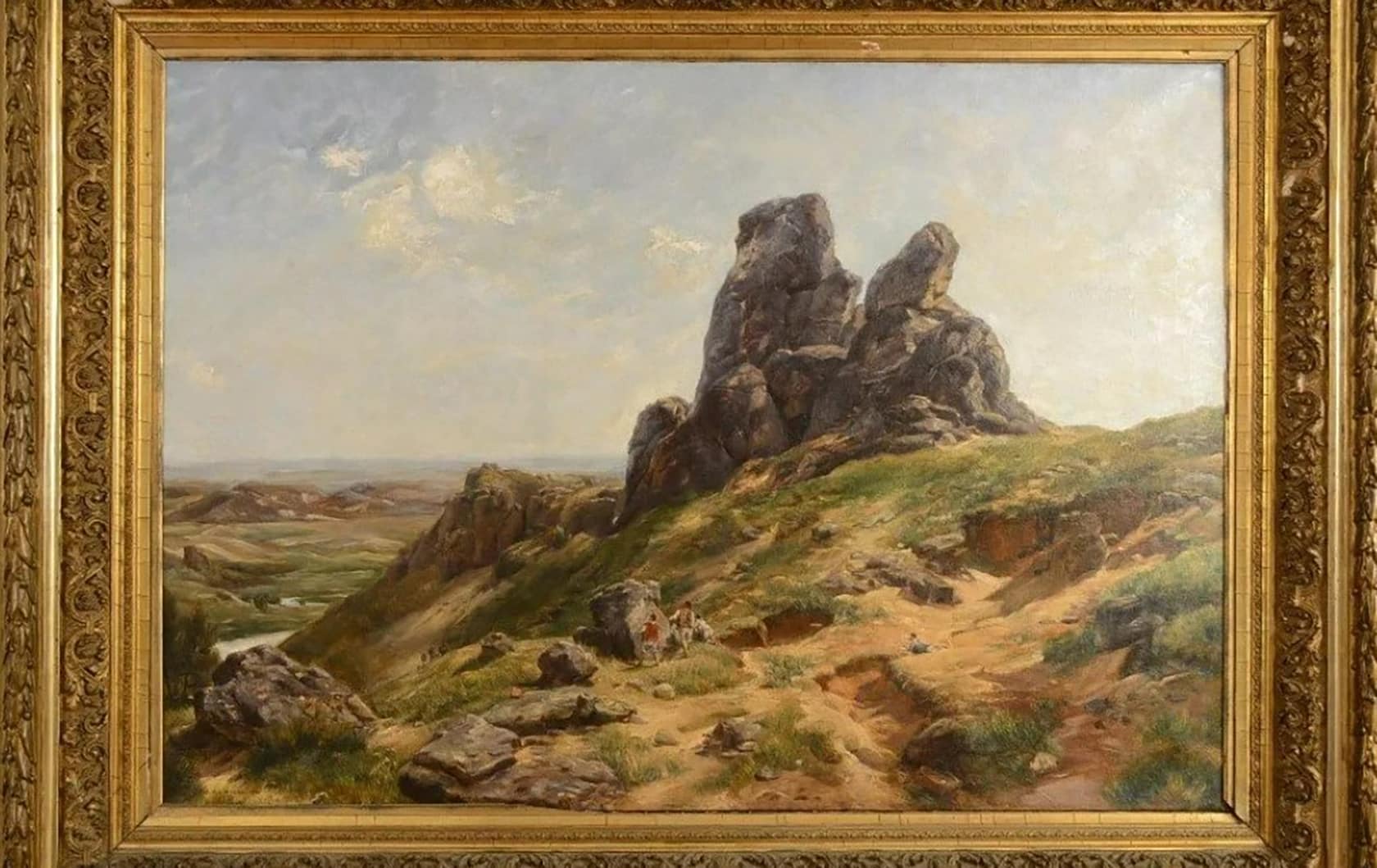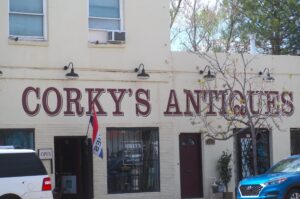
This painting of a Mexico valley, purportedly a work by José María Velasco in 1894, was purchased for $50,000 in 2020. (Screenshot of LiveAuctioneers.com)
Last Monday, two Denver District Court employees gently placed a large painting against a wall in the fourth-floor courtroom of Judge Jon Olafson, where it remained all week.
According to a signature in one of its corners, that depiction of a Mexican valley was painted in 1894 by José María Velasco, whose works are considered national treasures in Mexico. Jurors could see the painting from their seats as they listened to five days of talk about it.
And then, late in the day Friday, they determined it is a fraud — a $50,000 forgery.
The jury’s verdict capped off a colorful five-day civil trial that included discussion of deleted text messages and a threat of seizure by the Mexican government. It put a spotlight on two longtime Denver businesses: one an auction house, the other an antique shop.
The story has its origins in 2015, when Bruhns Auction Gallery, which had resided just off South Broadway for 40 years by then, listed the painting on behalf of a Mexican family. The family said that it was a Velasco, so gallery owner Tom Bruhns listed it as a Velasco, he said.
That drew a response from the Mexican consulate in Denver, which asked that Bruhns not sell the painting and that he prove it had not entered the U.S. in recent years. Velasco works can be repatriated to Mexico under an international agreement, in some cases.
To avoid repatriation, Tom Bruhns re-listed the painting for auction in 2016 as “attributed to José Velasco.” There was only one bidder, his longtime friend Corky Schaffer of nearby Schaffer’s Antiques along South Broadway, who got it for $8,000. Schaffer, who has been buying and selling for 50 years, much prefers Victorian-era furniture but was awed by the art.
“That piece is amazing, it’s incredible!” Schaffer testified last Thursday. “I thought I could sell it to a restaurant, a hotel. I mean, that is a piece that you talk about. Did I think that I had bought a real Velasco for $8,000? No, you can’t buy a Velasco for $8,000.”
Schaffer kept the painting at another auction house, which convinced him to have it authenticated by the foremost authority on Velasco: his great-granddaughter, Maria Elena Altamirano. It didn’t go well. She found that, signature aside, it isn’t a Velasco.
“If the foremost authority in the entire world said this is a fake, would you say it’s more likely than not that it’s a fake?” an attorney asked Friday, pointing at the painting.
“It’s probably not authentic,” said Bekka Saks, an appraiser of fine art at her family’s Saks Galleries in Cherry Creek, the oldest art gallery in the state.
After owning the painting for a few years, Schaffer decided to sell it in 2020. Dan O’Sullivan, an art dealer in Fort Collins, expressed interest and offered $50,000. Schaffer’s longtime friend Bruhns, who had sold him the painting, agreed to facilitate this sale to O’Sullivan.
“Because the deal was with Dan and he has trouble cashing checks, I said, ‘We need cash or we don’t have a deal,’” Bruhns recalled from the witness stand last Wednesday.
O’Sullivan didn’t have $50,000. So, he called his accountant, Shawn Hanson, who called a client of hers, Matthew Fugate. Hanson and Fugate took $50,000 from the bank, put it in an envelope, and Hanson went with O’Sullivan to Bruhns’ downtown Denver penthouse.
“I took a picture because I’ve never touched that much cash at one time,” Hanson said.
But when it came time to sign Bruhns’ purchase agreement, the buyers balked. O’Sullivan and Hanson didn’t like that it described the painting as a decorative piece rather than a Velasco. So, O’Sullivan and Hanson grabbed printer paper and hand-wrote a new contract, one that called the painting an original Velasco. That agreement was signed and the painting turned over.
“We thought it could be worth a lot of money,” Fugate told jurors last week, when asked why he bought the painting. “Hundreds of thousands of dollars, $300,000 to $600,000.”
Believing they’d just bought the pricey painting for a song, O’Sullivan and Hanson worked to have it authenticated. An online search turned up the name of the world’s foremost expert on Velasco: Altamirano, who, unbeknownst to them, had already declared it a fake.
After Altamirano told its new owners that the painting was not by her great-grandfather — the colors, composition and brushstrokes were all wrong, she said — the trio sued Bruhns, Schaffer and their companies for civil theft, breach of contract and civil conspiracy.
“You have no idea who painted this painting, right?” Colin McIver, an attorney for two of the plaintiffs, Hanson and Fugate, asked Bruhns on the witness stand last week.
“If you’re not there the day it is painted, you don’t really know,” the defendant said.
“Well, it was painted in 1894, so I think we can stipulate that none of us were there.”
Hanson, Fugate and O’Sullivan — who represented himself in the case — asked a jury of six Denverites to award them $500,000: What the painting might be worth if it was a Velasco. The defense seized on that number, which is 10 times’ the painting’s purchase price.
“This case is about greed!” said Bruhns’ lawyer, Wade Eldridge, during opening statements last Monday. McIver tried to object but Eldridge only grew louder. “It’s about the greed of Mr. O’Sullivan. It’s about the greed of Ms. Hansen. It’s about the greed of Mr. Fugate.”
Schaffer’s lawyer, Andrew Goertzel, accused the buyers of concocting false allegations after their “get-rich-quick scheme” didn’t pan out. “You can get blinded by greed and provide the world with yet another example of a fool and his money who are quickly parted.”
The defendants argued that Hanson and Fugate were suing the wrong person. It was O’Sullivan, the art expert, who had convinced them to buy the painting. O’Sullivan, who knew more about art than Bruhns or Schaffer. O’Sullivan, who didn’t do his homework.
“They’re saying that Tom is a thief, Corky is a thief!” Eldridge shouted at closing arguments, again over the objections of McIver. “That’s what he’s saying. ‘Tom is a thief because we were deceived.’ They weren’t deceived! They kept their eyes closed. Willful blindness.”
The plaintiffs and their attorneys made much of evidence they didn’t have: 21 text messages between Bruhns and Schaffer just before the sale in December 2020 that have somehow been erased from Bruhns’ phone. Bruhns and Schaffer say they didn’t discuss the painting’s lack of authentication then or any other time. The plaintiffs believe they did.
“Friends do not sell each other fake paintings,” Hanson said during her testimony.

Corky’s Antiques at 1449 S. Broadway is seen on Monday, April 29, 2024. (Justin Wingerter/BusinessDen)
Jurors, one of whom had expressed concern about missing a Monday flight if they didn’t reach a verdict Friday, began deliberating at 3:15 p.m. that day. Ninety minutes later, when asked if they would like to order pizza, they said that wouldn’t be necessary; they were almost done. After just 100 minutes of deliberation, the jury returned to the courtroom with a verdict.
Bruhns and Schaffer committed civil theft and breach of contract but not civil conspiracy, and their companies did nothing wrong, the jury decided. The jurors ordered Bruhns and Schaffer to pay a total of $10,200 to Hanson, $10,200 to Fugate and $0 to O’Sullivan. Bruhns and Schaffer also have to pay the plaintiffs’ attorney fees, which are still being tallied.
“Plaintiffs are extremely grateful to the jury for holding defendant Thomas Bruhns and defendant Lawrence Schaffer accountable for their civil theft and breach of contract,” McIver said Monday. “ … We hope the verdict will deter sellers from engaging in deception, will protect purchasers from being victimized, and will raise awareness of the remedies available to victims.”
Schaffer’s lawyer said the verdict “restored our faith in the American justice system.”
“That the jury only awarded nominal damages on the plaintiffs’ claims sends a clear message that accountability and personal responsibility still form an integral part of our judicial system,” Goertzel said Monday.
As for the painting that sat in Olafson’s courtroom last week, its history remains a mystery. O’Sullivan said, “It’s not from 1895, it’s probably from 1995, and it shows.” But Bruhns still maintains it could be a real Velasco. Saks, the art appraiser, testified “it could be an inauthentic painting that is not from the hand of the artist but the artist signed it.”
One former owner of the artwork doesn’t care one way or another about any of that.
“Maria Elena Altamirano looked at it and didn’t authenticate it,” McIver said to Schaffer while he was testifying Wednesday, to which Schaffer shrugged and said, “She has an opinion.”
“I have an opinion, too,” the shop owner said, “which is that it’s a beautiful piece of art.”
